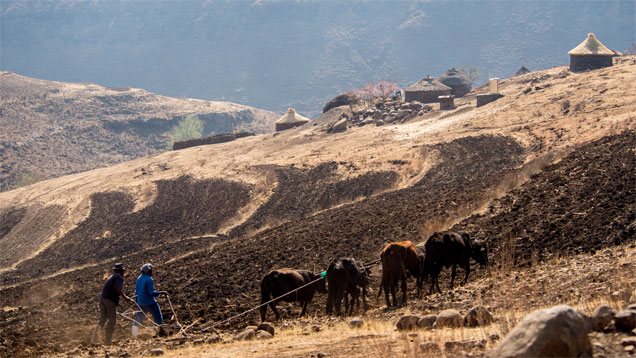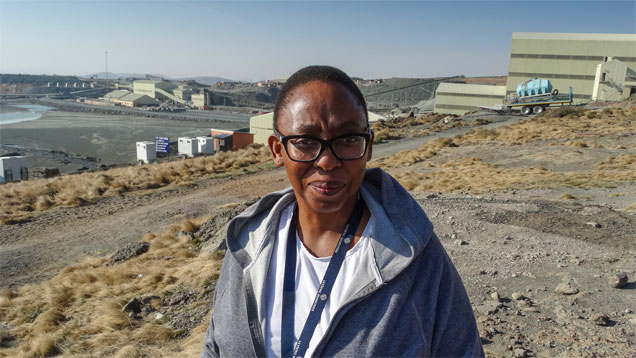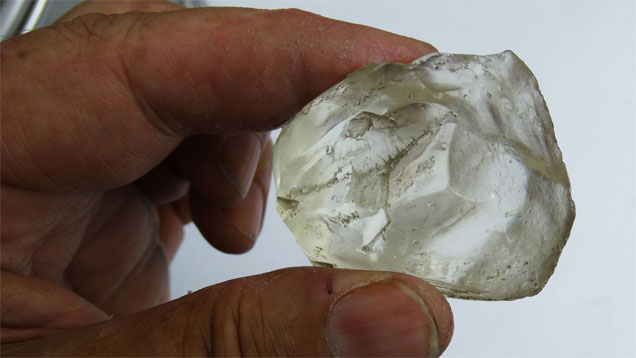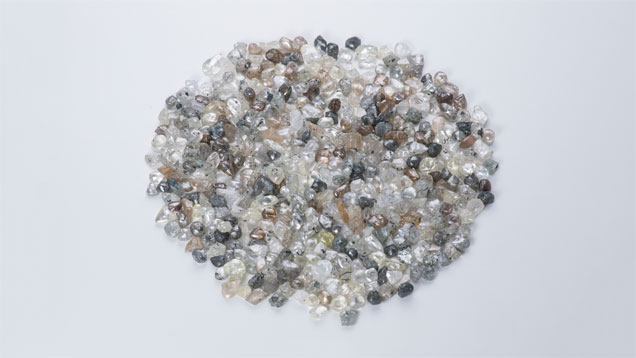Diamonds from the Roof of the World
October 10, 2014

For Mazvi Maharasoa, CEO of Letseng Diamonds, a partner in the mine, that diamond and the three 450 ct-plus diamonds that have been found there since are more than a promise—they are a source of national pride and a promise realized.
“This mine is unique, producing the highest average value diamonds ($2,043 per ct, against the global average of $106 per ct) in the world,” she says. “Lesotho is a dot on the map to some people, but these diamonds have brought us recognition.”
The mine is also one of the world’s largest sources of highly coveted type IIa diamonds. Normally, such stones comprise about 2% of diamonds recovered worldwide, but at Letseng, they are about one-quarter of the output.
Touring the mine, located about 3,100 meters (just over 10,000 feet) high in rugged mountain country, Maharasoa notes, “This mine came from nothing in 2000. Now we have 1,500 employees (and) a mine that gives our country 70% of its corporate tax revenue and 60% of our country’s foreign exchange earnings.”
Maharasoa was born in the capital city of Maseru and earned a degree in international and commercial law from the University of Buckinghamshire, north of London. She returned to Lesotho as legal advisor to the Ministry of Natural Resources.
“This is when I became acquainted with the diamond area,” she says, adding that negotiations over changes in the diamond laws and a new contract to restart Letseng were part of her work.

Mazvi Maharasoa, CEO of Letseng Diamonds. Photo by Russell Shor/GIA
Restarting production at the mine was a challenge. The kimberlite was discovered in 1957 by South African geologist Peter Nixon deep in the Maluti Mountains, amid farming villages and shepherd huts where it seemed that time had stood still for a millennium. It wasn’t until the following year that two South African prospectors, Keith Whitlock and Jack Scott, set out in search of diamonds. They endured extreme cold and blizzards and returned with about 1,800 cts of diamonds.For several years, the government allowed artisanal miners to file claims and work the site, but in 1968, it invited the mining giant RTZ (now Rio Tinto) to prospect the area. The company worked to develop the mine for four years but determined that the grade of the ore (less than two cts per 100
tons) was too low to mine profitably.
After RTZ moved on, the government invited then-De Beers chairman Harry Oppenheimer to have a look. As a result of his visit, De Beers set up a limited operation, mining the richest areas of the main kimberlite for almost a decade before closing it in 1982 when the global diamond industry fell into a deep crisis.
The site sat fallow for almost 20 years. Several companies leased it but couldn’t find a way to make a profit. Political instability in Maseru did not help, especially when it exploded into violence in 1998, which destroyed much of the capital and several surrounding towns.
When peace was restored the following year, the factions formed a unified government, which decided to restart Letseng to get funds flowing into the national treasury. It created the Letseng Diamond Company to acquire the mining lease from the South African gold mining firm that had held it for several years. It took five years to resume small-scale production—less than 40,000 cts per year.
By 2004, Maharasoa had become an executive with the Central Bank of Lesotho, which was working with the government on a deal for Gem Diamonds to acquire a 70% interest in the mine. “The (kimberlite) pipes at the mine were never properly explored, so there was a lot of work to do,” she says. “And even now, (there is) still a lot of work remaining.”
The Lesotho Promise turned up shortly after Gem Diamonds resumed mining operations in 2006. The company sold it for $12.4 million to Safdico, the South African polishing firm majority-owned by London-based jeweler Laurence Graff.
Graff’s cutters spent a year working on the Lesotho Promise. While potentially D-color, it was dappled with black inclusions, making the planning process look more like a battle map, according to a video Graff produced about cutting the diamond.
Twenty-six GIA-graded D-color Flawless diamonds were cut from it, the largest of them a 76.41 ct pear shape graduating down to a 0.55 ct round brilliant. Graff inscribed serial numbers on each of them to indicate their origin. All 26 diamonds were used to design a necklace with a total weight of 223 cts.

A replica of the Lesotho Promise diamond. Photo by Russell Shor/GIA
By the time Maharasoa joined Letseng in 2009 as CEO, the company had unearthed the 493 ct Letseng Legacy (2007) that Graff/Safdico purchased for $10 million and the 478 ct Light of Letseng (2008), which yielded the 102.79 ct Graff Constellation (2009), which was graded by GIA and according to Graff is the largest known D-Flawless round brilliant diamond.Shortly after her arrival, the company announced that it had found two colorless diamonds weighing 196 and 184 cts. In September 2014, the company sold a 198 ct potentially D-Flawless diamond at its Antwerp sale for $10.6 million. These finds have helped seal Letseng’s global reputation as a supplier of large, fine diamonds.
Mining here remains challenging, Maharasoa says.
“It is the world’s highest active diamond mine, so the weather is extremely volatile, going down to –25°C in winter,” she says. “We have to maintain our part of the road that not only supplies us with access to and from the mine, but links the town of Mokhotlong to the north of us.”
Supplying the mine with food, fuel and equipment is no small logistical matter, either.
“We use 1.5 million liters of fuel each month, which all has to come by truck,” Maharasoa says. “And then there’s the challenge of getting our 50-ton Caterpillar mining trucks up the mountains to our site.”
Despite these demands, Gem Diamonds has more than doubled the mine’s production in five years to about 100,000 cts a year.
“Letseng has a long life ahead,” Maharasoa says. “We have established a goal that Lesotho’s diamonds, now supplying about 7.5% of our country’s GDP, can achieve 15% within a few years.”
 The mining output at Letseng has almost doubled in five years, despite the challenges of mining at 10,000-foot elevations. This mixed production of 204.89 ct goods is but a small portion of production achieved during a five-day mining period. Photo by Robert Weldon/GIA
The mining output at Letseng has almost doubled in five years, despite the challenges of mining at 10,000-foot elevations. This mixed production of 204.89 ct goods is but a small portion of production achieved during a five-day mining period. Photo by Robert Weldon/GIA
About The Authors
Russell Shor is senior industry analyst and Robert Weldon is manager of photography and visual communications at GIA in Carlsbad, California.



